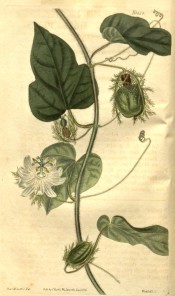Passiflora foetida L.
Frost-tender, vigorous climber or trailer with 3-5-lobed leaves and green and white, fragrant flowers, to 5cm across, and white filaments, banded violet, followed by yellow to bright red fruit, to 2.5cm across. The crushed foliage has a malodorous smell. [RHSD, Don].
Horticultural & Botanical History
‘Native of the West Indies, cultivated by Miller at the Chelsea Physic garden in 1731. Generally accounted annual; but we are assured by Messrs. Whitley and Co. at whose nursery the drawing was taken in July last, that it is perennial. Requires to be kept in the stove. The whole plant, when touched, emits a rank herbaceous scent, resembling that of the Common Dead Nettle. Miller describes the fruit as of a roundish oval form, and of the size of an ordinary Golden Pippin.’ [BR f.321/1818].
‘Requires to be kept in the stove, where it will reach the height of several feet and bear a profusion of flowers in succession, but each of only a few hours duration.’ [BM t.2619/1826].
‘This is a curious but not splendid sort. […] The flowers are wholly white on the inside, and greenish on the outside of the external petals. The ray is pure white.’ [LBC no.725/1823]. Introduced to Europe in 1731. [PD].
History at Camden Park
Listed in the 1857 catalogue only [T.727/1857].
Notes
Published Jan 31, 2010 - 02:21 PM | Last updated Jul 29, 2010 - 02:03 PM
| Family | Passifloraceae |
|---|---|
| Category | |
| Region of origin | South America, Caribbean |
| Synonyms |
|
| Common Name | Stinking passionflower |
| Name in the Camden Park Record |
Passiflora foetida BM |
| Confidence level | high |
